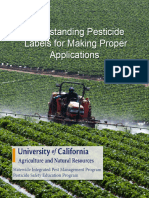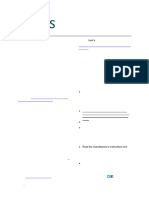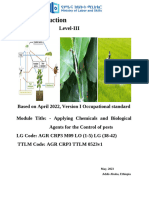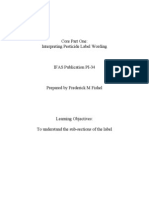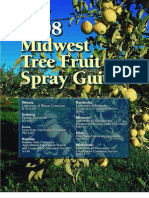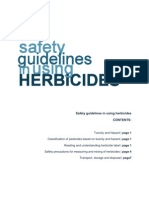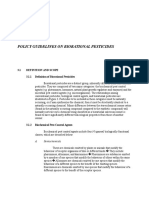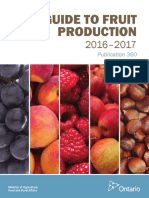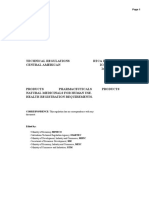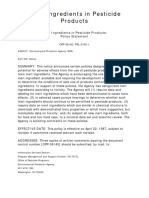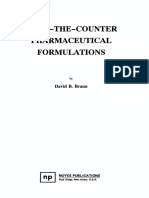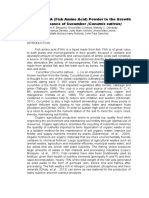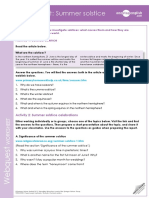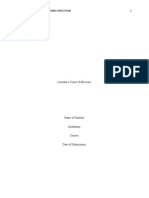0 ratings0% found this document useful (0 votes)
31 viewsSection 1: The Importance of Pesticide Labeling
Section 1: The Importance of Pesticide Labeling
Uploaded by
Melody DacanayThe document discusses pesticide labeling and its importance. Key points:
1. Pesticide labels are legally required and provide critical instructions for safe use, based on extensive testing.
2. The EPA must approve all label language and ingredients before a pesticide can be sold. Labels include toxicity, environmental, and effectiveness testing results.
3. It is important for applicators to read labels before purchase and use to understand safety precautions, equipment requirements, and approved applications. Following label instructions exactly is necessary for legal and safe use.
Copyright:
© All Rights Reserved
Available Formats
Download as DOCX, PDF, TXT or read online from Scribd
Section 1: The Importance of Pesticide Labeling
Section 1: The Importance of Pesticide Labeling
Uploaded by
Melody Dacanay0 ratings0% found this document useful (0 votes)
31 views8 pagesThe document discusses pesticide labeling and its importance. Key points:
1. Pesticide labels are legally required and provide critical instructions for safe use, based on extensive testing.
2. The EPA must approve all label language and ingredients before a pesticide can be sold. Labels include toxicity, environmental, and effectiveness testing results.
3. It is important for applicators to read labels before purchase and use to understand safety precautions, equipment requirements, and approved applications. Following label instructions exactly is necessary for legal and safe use.
Original Title
local_media963732157
Copyright
© © All Rights Reserved
Available Formats
DOCX, PDF, TXT or read online from Scribd
Share this document
Did you find this document useful?
Is this content inappropriate?
The document discusses pesticide labeling and its importance. Key points:
1. Pesticide labels are legally required and provide critical instructions for safe use, based on extensive testing.
2. The EPA must approve all label language and ingredients before a pesticide can be sold. Labels include toxicity, environmental, and effectiveness testing results.
3. It is important for applicators to read labels before purchase and use to understand safety precautions, equipment requirements, and approved applications. Following label instructions exactly is necessary for legal and safe use.
Copyright:
© All Rights Reserved
Available Formats
Download as DOCX, PDF, TXT or read online from Scribd
Download as docx, pdf, or txt
0 ratings0% found this document useful (0 votes)
31 views8 pagesSection 1: The Importance of Pesticide Labeling
Section 1: The Importance of Pesticide Labeling
Uploaded by
Melody DacanayThe document discusses pesticide labeling and its importance. Key points:
1. Pesticide labels are legally required and provide critical instructions for safe use, based on extensive testing.
2. The EPA must approve all label language and ingredients before a pesticide can be sold. Labels include toxicity, environmental, and effectiveness testing results.
3. It is important for applicators to read labels before purchase and use to understand safety precautions, equipment requirements, and approved applications. Following label instructions exactly is necessary for legal and safe use.
Copyright:
© All Rights Reserved
Available Formats
Download as DOCX, PDF, TXT or read online from Scribd
Download as docx, pdf, or txt
You are on page 1of 8
LESSON 3: The Pesticide Labeling because so much important information on how to use
a pesticide is found on the label. This information is the
This Chapter describes pesticide labeling, which includes result of years of research and testing for each pesticide
the label itself plus all other information referenced on that is put on the market. A manufacturer may make
the label or received from the manufacturer when you and screen thousands of compounds before finding one
buy the product. By law, pesticide users are required to that can pass all the tests needed for a label to receive
comply with all the instructions and use directions clearance from the EPA. These tests include the
found on the pesticide labeling. The pesticide product following:
label is the main method of communication between a
pesticide manufacturer and pesticide users. The labeling Toxicological tests to determine possible
may include brochures, leaflets, and other information health hazards to humans and animals.
Metabolism studies to see how long it takes a
that accompanies the pesticide product. Pesticide
compound to break down into simple, less toxic
labeling provides applicators with specific instructions
materials.
on how to use products safely and correctly. Residue tests to find out how much of the
pesticide or its breakdown products remain on
Section 1: The Importance of Pesticide Labeling farm products, such as crops, meat, milk, and
eggs.
One of the more important tools to ensure the safe and
Soil movement tests to determine how long a
effective use of pesticides is the product label. Pesticide pesticide stays in the soil, and how it moves in
manufacturers are required by law to put certain the soil and groundwater.
information on the label. Labels are legal documents Wildlife tests to determine the immediate and
providing directions on how to mix, apply, store, and long-range effects on wildlife.
dispose of pesticide products. As part of the registration Performance tests to prove that the pesticide
process, the U.S. Environmental Protection Agency controls the pest and improves the quality and
quantity of the crop.
(EPA) must approve all language that the manufacturer
The EPA reviews these test results and determines
(registrant) proposes to include in the product labeling. whether to approve the pesticide. Once it is
The EPA reviews the labeling to make sure it contains all approved, the pesticide is registered. Information
the information needed for safe and effective use of the on the label and labeling must not differ from the
pesticide product. Only after the EPA has reviewed the information given to the EPA when the product was
labeling and registered the product can a pesticide be registered.
sold for use in the United States. A pesticide must also The label is the information printed on or attached
be registered with the Minnesota Department of to the pesticide container or wrapper; labeling
Agriculture (MDA) before it can be sold, distributed, or refers to the label plus all additional product
used in the state. This Section describes the reasons information, such as brochures and flyers, provided
that pesticide labeling is so important to the applicator. by the manufacturer or dealer. Both the label and
labeling are legally binding documents and must be
Learning Objectives:
followed. State labels—that is, special local needs
1. Explain the difference between the pesticide label and emergency exemption labels—should be in
and pesticide labeling. your hands at the time of application.
2. List two reasons why the EPA registration number is
placed on a product label. Types of Pesticide Registration
3. List at least three reasons why reading a pesticide
label is important to the pesticide applicator. You are responsible for applying only pesticides
registered with both the EPA and the MDA. A registered
Basis of Pesticide Labeling pesticide is one that has been researched and approved
by the EPA for uses that are specified on the label and
In this manual you will often be advised to “read the
labeling. Look for the EPA registration number that
label” and “follow the directions on the label.” That’s
must appear on all pesticide labels that confirms EPA When to Read the Pesticide Label
registration. The Federal Insecticide, Fungicide, and It is important for applicators to read and understand
Rodenticide Act (FIFRA) allows for three variations from the pesticide label. Important times to read the label
the standard pesticide registration process, each of include:
which is named for the part FIFRA where they are
Before buying the pesticide. Make sure the
described.
pesticide is registered for your intended use.
24(c) Special Local Need Registrations Understand any site restrictions. Be certain its
Special Local Need (SLN) registrations, also called 24(c) use is suitable for weather conditions at the
registrations, allow states to apply to EPA to expand or time of application. Find out what personal
limit labeled uses of already registered pesticides to protective equipment and special application
accommodate area-specific conditions. In some cases, equipment will be needed.
SLN registration may allow pesticide use on minor crops Before mixing and applying the pesticide. Learn
not specified on the label, and in other cases SLN how to mix and apply the material safely. Find
registration will add more restrictive use limitations out what precautions to take to prevent
than those found on the label. You must have the SLN exposure to people and non-target organisms.
additional labeling in your possession to use the Learn what first aid and medical treatments are
pesticide for any purpose not listed on the label. These necessary should an accident occur.
registrations are legal only in the region, state, or local When storing pesticides. Find out how to store
area specified in the SLN labeling. the pesticide properly. Understand the special
precautions to prevent fire hazards or spills.
Section 18 Emergency Exemptions
Emergency exemptions address pest problems for Section 2: Parts of the Label
which no pesticides are registered. The EPA can issue an
emergency exemption at the request of the state It is the user’s responsibility to read and understand the
regulatory agency. Usually these needs are based on
label before buying, using, storing, or disposing of a
specific public health emergencies or other crises that
pesticide. This Section will describe the various label
require the use of an unregistered pesticide. There must
be no feasible alternative to the exemption. Known as a components and what important information these
Section 18 exemption, it allows the sale and use of a label parts provide for pesticide applicators. Parts of the
certain pesticide product for a specific non-registered example label on page 64 will be used to illustrate label
purpose during a specified period of time. For example, parts.
in 2004 some products received Minnesota Section 18
Emergency Exemption for use on soybeans to combat Learning Objectives:
soybean rust. Applicators must have a copy in their 1. Compare and contrast pesticide trade, common, and
possession and follow the instructions in the Section 18 chemical names.
approval letter from EPA to the state to legally use the 2. List and define pesticide label “signal words.”
product. 3. Describe where you should look on a pesticide label
to find out what to do if a pesticide gets on the skin, in
Section 25(b) Minimum-risk Pesticides the eyes, is swallowed, or inhaled.
EPA has reviewed and identified a number of
substances that are generally considered minimum risk Trade, Brand, or Product Name
when used as a pesticide and are exempt from EPA The brand or trade name shows up plainly on the front
pesticide registration under Section 25(b) of FIFRA. panel of the label and is the one used in advertisements
and by company sales people. Manufacturers use
These products are not required to go through the
different trade names, even though the products
formal EPA label review and registration approval
contain the same active ingredient. The brand name
process and have no EPA registration number. often indicates the type of formulation and the
Minnesota, like a number of states, also does not percentage of active ingredient present. For example, in
require 25(b) products to be registered with the MDA. the sample label on page 68, “VIP No Pest Gel” is a
registered trade or brand name of the product. Gel in applicators to apply RUPs in Minnesota. Remember if
the brand name indicates the product’s formulation. you hire a service to apply pesticides on your farm, the
applicator must hold a commercial pesticide applicator
Ingredient Statement
license to apply any pesticide, RUPs and non-RUPs.
Every pesticide label has an ingredient statement that
provides the amount of active ingredients (those that Type of Pesticide
the manufacturer claims have effects on the targeted
pests) in the formulation, the official chemical name, The type of pesticide is usually listed on the front panel
and amount of other ingredients. of the pesticide label. This short statement indicates in
general terms where the product can be used. Examples
Other ingredients (often called inert ingredients) are
substances added to the active ingredients to formulate of description of pesticide types include the following:
the final usable product, but have no effect on targeted
Insecticide for control of certain insects on fruits, nuts, and
pests. Unlike active ingredients, these other ingredients
ornamentals.
are considered proprietary information. Inert
ingredients that are not considered hazardous and are Insecticide for broad-spectrum control of crawling, flying, and
less than 1 percent of the product may not require wood-infesting insect pests on indoor and outdoor surfaces,
listing on the MSDS label. The other ingredients may as well as pests of trees, landscape ornamentals, and
have effects on humans or other animals, plants, or the
residential and commercial lawns.
environment. However, the EPA maintains a list of other
ingredients that are not considered to pose excess Herbicide for the control of woody brush and weeds.
hazards to non-target organisms, and manufacturers
choose from this list when they formulate products. Net Contents
The pesticide label must show how much product is in
The chemical name is the scientific name that identifies the container. This is expressed as pounds or ounces for
the chemical components and structure of the dry formulations or as gallons, quarts, or pints for
pesticide’s active ingredient. Because chemical names liquids. Liquid formulations may also list the pounds of
of active ingredients are usually complex, many are active ingredient per gallon of product.
given a shorter common name. Only those common
names officially accepted by the EPA may be used in the Name and Address of Manufacturer
ingredient statement on the pesticide label. Labels are The law requires that the manufacturer or formulator of
not required to include the common name in the a product put the name and address of the company on
ingredients statement. By referring to the common or
the label.
chemical names, rather than the brand name alone, you
are certain of getting the right product for your needs.
In the sample label on page 69, “galactothion” is the Emergency Telephone Number
common name and “0,0-diethyl methyl Many pesticide manufacturers include emergency
phosphorothiate” is the chemical name of the active telephone numbers on their product labels to provide
ingredient. customers technical information on how to respond in
the event of an emergency (poisoning, spill, fire)
Use Classification Statement
involving their products.
The EPA classifies some pesticide products as restricted
use (RUP). Every product that is federally classified as a Registration Numbers
restricted-use pesticide must include the following An EPA registration number must appear on all
statement at the top of the front panel of the pesticide pesticide labels, except those designated by EPA as
label: 25(b) minimum-risk pesticides. The EPA registration
number indicates that the pesticide product has been
Unclassified or general-use pesticides can be purchased registered and its label approved by the EPA. For special
and used by the general public or by farmers without local needs registration, the EPA registration number
certification. Farmers and other producers of will start with SLN.
agricultural commodities must be certified as private
Establishment Number through the skin and eyes). Specific action statements
Don’t confuse the EPA establishment number with the usually follow, either directing or recommending
EPA registration number. An EPA establishment number specific precautions. These statements are particularly
identifies the facility where the pesticide was produced. important if the label does not list required personal
This is required on the product label in case a problem protective equipment. These statements are directly
arises or the product is found to be adulterated in any related to the pesticide’s acute toxicity and signal
way. words. Many pesticide products are hazardous by more
than one route of entry. Study these statements to
Signal Words and Symbols understand how you may be exposed and what to do to
Most pesticide labels must include a signal word. This prevent exposure. The table on page 73 shows
important designation gives the user an indication of examples of signal words and corresponding
the relative acute human toxicity and help you choose precautionary statements that you might see on a label.
the least toxic chemical that provides the needed level
Protective Clothing and Equipment Statements
of pest control (for more about signal words, their
meaning and toxicity, see chart on page 234, Appendix
Pesticide labels vary in the type of information they
A, Pesticide Toxicities and Chapter 6, Health and Safety). contain on protective clothing and equipment. Some
The signal word must appear in large letters on the pesticide labels fully describe appropriate protective
front panel of the pesticide label along with the clothing and equipment, while others carry no PPE
statement “Keep out of Reach of Children.” Very low information at all. Some labels list the kinds of
toxicity pesticides (Toxicity Category IV) are no longer respirators that must be worn when handling and
applying the product; others require the use of a
required to display a signal word, although many
respirator, but do not specify a type or model. More
manufacturers still include a “CAUTION” signal word on detailed information may be found on the pesticide’s
the label of these products. Material Safety Data Sheets or MSDS. Follow all
directives on protective clothing or equipment that
Precautionary Statements appears on the label and in the MSDS. Labels list the
Pesticide labels contain statements on how applicators minimum PPE required, but applicators can choose to
can protect themselves, their employees, and other use more. To determine the proper type of protective
persons or animals. Sometimes these statements are clothing and equipment, also consider the signal word,
listed under the heading “Hazards to Humans and the route of entry statements, the specific action
Domestic Animals” or may be included in other sections statements, and the MSDS.
of the label. Personal protective equipment (PPE) listed
in precautionary statements included on the label must Other Precautionary Statements
be worn during use of the pesticide. Hazard Labels often list other precautions that should always be
statements (hazards to humans and domestic animals, followed when handling the product. These are self-
environmental hazards, and physical or chemical explanatory and common sense statements. The
hazards) are not located in the same place on all absence of such statements from the label does not
pesticide labels. Some labels group them under the indicate that these precautions should be ignored.
headings listed above. Other labels list them on the Do not contaminate food or feed.
front panel beneath the signal word. Still other labels Remove and wash contaminated clothing
list the hazards in paragraph form somewhere else on before reuse.
the label under headings such as “Note” or “Important.” Wash thoroughly after handling and before
Before using a pesticide, read and understand the label eating or smoking.
to ensure that you handle the product properly and Do not allow children or domestic animals into
safely. The following types of precautionary statements the treated area.
found on the label give the pesticide applicator the best
instructions on how to prevent problems. First Aid
The first aid section on the label, sometimes called
Routes of Entry and Specific Action Statements “Statement of Practical Treatment,” lists actions to be
Routes of entry and specific action statements go hand- taken in case of poisoning or accidental exposure. All
in-hand. Routes of entry indicate how the pesticide DANGER labels and some WARNING and CAUTION
enters the human body (orally, inhaling, or absorbing labels contain a note to physicians describing the
appropriate medical procedures and antidotes for Agricultural Use Requirements
poisoning emergencies. The label should always be
available in case of emergencies. An “Agricultural Use Requirement” box is found
only on labels of products that are covered by the
Environmental Hazards EPA Worker Protection Standard (WPS). The box
Some products are classified as restricted-use because contains information about WPS and lists product-
of the environmental hazards they may pose. Watch for specific requirements for WPS-covered workers and
special warning statements on the label concerning handlers. These listed requirements include WPS
hazards to the environment. Different types of restricted-entry intervals (REI) and PPE for WPS-
environmental hazard statements may be included on covered handlers and early-entry workers. The WPS
the label. REI specifies how much time must pass between the
application of a pesticide and the reentry of
General Environmental Statements unprotected workers into a treated area. If there
General environmental label statements are reminders are multiple REIs on a label, you can usually find the
to follow certain common-sense procedures to avoid appropriate REI at the beginning of the use-
contaminating the environment. The absence of any or direction section for each crop. If no REI statement
all of these statements does not mean that you do not or other entry restrictions appears on the label,
need to take adequate precaution. Examples of general then all persons should wait at least until sprays
environmental statements include: w Do not apply have dried or dusts have settled before reentering a
when runoff is likely to occur. w Do not apply when treated area without label-required PPE. An
weather conditions favor drift from treated areas. w Do example of an Agricultural Use Requirements is
not contaminate water by improperly disposing of rinse shown below.
water and other pesticide wastes. w Do not apply when Non-agricultural Use Requirements
bees are likely to be in the area. w Do not apply directly The requirements in this Section apply to pesticide
to water or to areas where surface water is present or uses that are not within the scope of the WPS, such
to intertidal areas below the mean high-water mark. w as the application of pesticides to lawns, golf
The use of this chemical in areas where soils are courses, ornamental plantings, structures (except
permeable, particularly where the water table is greenhouses), aquatic areas, and rights-of-way.
shallow, may result in groundwater contamination. Specific reentry times are not generally listed for
these uses, though the label often cautions people
Hazards to Wildlife Statements and pets not to enter treated areas until spray has
If a pesticide is especially hazardous to wildlife, the label dried or dust has settled.
will say that. The label statement helps applicators
choose the safest product for a particular job and Storage and Disposal
reminds them to take extra precautions. For example: All pesticide labels contain general instructions for
This product is highly toxic to bees. the appropriate storage and disposal of the
This product is extremely toxic to fish and pesticide and its container. One or more statements
aquatic invertebrates. may appear in a special section of the label titled
This product is toxic to birds and other wildlife.
“Storage and Disposal” or under headings such as
Physical or Chemical Hazards “Important,” “Note,” or “General Instructions.”
This section of the label describes any special fire, These may include: w Store herbicides away from
explosion, or chemical hazards the product may pose. fertilizers, insecticides, fungicides, and seeds. w
For example: Store at temperatures above 32°F (0°C). w Do not
Flammable—do not use, pour, spill, or store reuse container; render unusable. w Do not
near heat or open flame. Do not cut or weld contaminate water, food, or feed by storage or
container.
disposal. w Triple-rinse, or equivalent, and dispose
Corrosive—store only in a corrosion-resistant
tank. of in an approved landfill..
Directions for Use
These instructions provide the directions on how to use
the product. The use instructions will tell you:
The crop, animal, or site the product is intended product’s composition, physical and chemical properties
to protect. and hazards, toxicological and ecological information,
The pests that the manufacturer claims the and first aid procedures. Emergency responders often
product will control. require the product MSDS before responding to
How much to use (rate) and how often.
incidents involving pesticides and other chemicals.
Where and when the material should be
applied. Businesses using pesticides and other products are
The proper mixing instructions. required to keep appropriate MSDS and make them
How to minimize drift. w Phytotoxicity (damage available to workers or others who may come into
to plants) and other possible injury. contact with the substance, its diluted end product, or
How close to harvest the product can be its residues. Private applicators should obtain MSDS for
applied. the pesticides they use. MSDS are available from
Re-cropping, composting, grazing, and other
manufacturers and distributors of pesticides. Pesticide
restrictions.
applicators should review the toxicological, first aid, and
PPE sections of the MSDS before handling a pesticide
Label Summary
concentrate. Because MSDS are technical documents,
Many terms are used on labels to describe when and
parts of them can be difficult to understand. Ideally, the
how to use pesticides. Your understanding of these
MSDS is used in combination with the pesticide label,
terms will help you obtain optimum results from
but it should never be used in place of the actual
pesticide applications. Refer to the Appendix B, Glossary
product label.
in this manual to look up a term. If you do not
understand the directions on a label, check with your
pesticide dealer or salesperson, the University of Components of the MSDS
Minnesota Extension, or the Minnesota Department of The information contained in the MSDS may appear
Agriculture. The label provides a wealth of information under various headings and does not have to follow the
for pesticide applicators. Remember, the label is a legal same order, but the elements of all MSDS are the same.
document. It is illegal and considered a misuse to use
any registered pesticide in a manner inconsistent with Chemical Product Identification
its labeling. Following label directions maximizes As with the pesticide label, the MSDS identifies the
effective control of pests and minimizes hazards to ingredients in the product by common (generic) name,
people and the environment. percentage of the active ingredient(s), and percentage
of inert or other ingredients. This section of the MSDS
Section 3: Material Safety Data Sheets (MSDS) may also provide information about the class of
chemical, such as “organophosphate insecticide” or
Material Safety
“chlorophenoxy herbicide.” Because chemicals in a
Data Sheets (MSDS) are very useful documents for
particular class share certain characteristics, this
learning about specific chemical and physical properties
information may be helpful, particularly to the health-
of pesticides or other potentially hazardous substances.
care professional. This section also may provide brand
Manufacturers of these substances are required to
names of other products with the same composition.
develop and to provide upon request an MSDS for each
product. The information in the MSDS complements the
Physical and Chemical Properties
pesticide label. This Section describes the information a
This Section describes the product’s physical
pesticide applicator can obtain from the MSDS and
appearance and provides information about how the
where to find them.
product behaves under certain physical and chemical
conditions. Particularly relevant are the measures for
While the pesticide label focuses on how to use the
water solubility, vapor pressure, soil KOC, stability, and
product safely, the MSDS provides technical information
freezing/boiling point. These physical and chemical
about the product’s hazards to workers and end users.
The MSDS provides detailed information about the
properties can impact mixing and storage, drift, Acute toxicity,
leaching, and runoff. Chronic toxicity,
Delayed toxicity,
The Soil Organic Carbon-Water Partitioning Coefficient Oncogenicity (ability to cause tumors),
(or soil KOC) is the ratio of the mass of a chemical that is Carcinogenicity (ability to cause malignant tumors, or
adsorbed by soil per unit mass of organic carbon in the cancer),
soil per the equilibrium chemical concentration in Teratogenicity (ability to cause birth defects), and
solution. Soil KOC values are useful in predicting the Fetotoxicity (other adverse effects on the fetus, such as
mobility of pesticides; higher KOC values correlate to low birth weight or spontaneous abortion).
less mobility, while lower KOC values correlate to more
mobility. This parameter is used to calculate a soil The MSDS also lists symptoms of acute overexposure
concentration that protects groundwater. and usually lists medical conditions that may be
aggravated by exposure to the product. It is important
From a human exposure standpoint, products with high to remember that a substance’s level of acute toxicity is
water solubility are not stored in body fat but excreted not related to its ability to cause chronic or delayed
in urine. Products with relatively high volatility are more effects. The MSDS usually provides specific information
likely to be detected through smell than products with about the product’s ability to cause eye and skin
low volatility. Some MSDS provide direct information irritation or allergic responses.
about the odor of a product. Products may range from
practically odorless to very strong in odor. Allergic responses are also not related to the chemical’s
Stability and the freezing and boiling points of a level of acute toxicity. Thus, it is possible for a slightly
substance determine whether a product can be stored toxic pesticide (Category III) to be associated with
over the summer or winter. Freezing and excessive adverse long-term effects or allergic reactions and,
heating may degrade the product, resulting in a loss of conversely, for a highly toxic pesticide (Category I) to
efficacy against the pest. have no known longterm or allergic effects.
Fire and Explosion Hazards Cholinesterase Inhibitors
Some substances can spontaneously catch on fire at a If the pesticide can inhibit cholinesterase, an enzyme
certain temperature. In such cases, the MSDS identifies that regulates nerve impulses, the MSDS may identify
the temperature, called the flash point, at which the the pesticide as a cholinesterase inhibitor.
substance catches fire. The MSDS may list conditions to Cholinesterase inhibitors are a class of compound that
avoid, such as materials that are incompatible with the includes chemical warfare nerve agents and certain
product. For instance, some substances can react with insecticides. Cholinesterase inhibitors can have serious
galvanized containers to form hydrogen gas, a highly health effects, such as depression of respiratory drive,
combustible material. paralysis of muscles of respiration, and airway
constriction.
Toxicological Information/Human Health Data
The MSDS identifies by what route(s) of exposure the Regulatory Exposure Limits
product may be harmful (for example, ingestion, Some compounds have regulatory limits on the
through the mouth; dermal, through the skin or eyes; concentration and the amount of time a worker can be
and inhalation, by breathing in the product’s vapors). exposed to them. These limits are based on the
The MSDS also summarizes results of toxicological tests concentrated product, rather than the diluted or mixed
performed on laboratory animals and discusses the form, and are listed in the MSDS.
potential for effects on humans. Here is a list of Personal Protection Recommendations
toxicological and health data commonly found on Many products do not require special protective
MSDS: equipment. Others require chemical-proof gloves,
goggles, respirators, or other gear. Remember that the Summary
equipment listed on the MSDS pertains to the product The language on pesticide labels is strictly regulated
as formulated. Refer to the pesticide label to check by the EPA, in coordination with pesticide
whether protective gear listed on the MSDS is required manufacturers, to provide precise information on
to be worn while handling the diluted product. how to use pesticides correctly and safely. It is the
applicator’s responsibility to read, understand, and
Additional Information follow the label directions to ensure that pesticides
The MSDS must also provide: are applied according to regulations. The label
Emergency and first aid procedures—specific directions are written to instruct the applicator how
information about first aid and emergency to use the pesticide for effective control of the
treatment for persons exposed to the product. target pest while minimizing harmful effects to
The MSDS provides treatment information for other organisms and the environment. Make sure
emergency responders and physicians. the pesticide has both federal and state registration
Ecological or environmental hazards— for its intended use.
information on acute and chronic effects on
wildlife in similar terms as the statements Pesticide labels in combination with MSDS provide a
pertaining to humans. wealth of information on the hazards associated
Spills, fires, and accident procedures— with each pesticide. Carefully review these
directions for cleaning up spills and leaks, as documents before applying any pesticide.
well as special information for firefighters. Applicators are better prepared to avoid any
Storage and disposal—directions on how to harmful effects if they understand the properties of
store and properly dispose of the pesticide. This the pesticide thoroughly. Remember, it is the
information may range from very specific to applicator’s responsibility to ensure that pesticides
quite general. are applied effectively and as safely as possible.
Have an MSDS available for every pesticide product
that you are using. Read both the pesticide label
and the MSDS for a more complete picture of the
potential hazards associated with the pesticide.
Both the label and the MSDS provide valuable
information in case of a pesticide emergency.
You might also like
- Crop Protection GuideDocument148 pagesCrop Protection GuideOyedele AjagbeNo ratings yet
- The Rubaiyat of Jalal Al Dine RumiDocument77 pagesThe Rubaiyat of Jalal Al Dine Rumitomototi0% (1)
- Dali and Surrealism. IntroductionDocument12 pagesDali and Surrealism. IntroductionLarine0% (1)
- Pesticide Labels EnglishDocument31 pagesPesticide Labels Englishileana.luqueNo ratings yet
- LESSON 2: Pesticide Laws: Section 1: Federal Insecticide, Fungicide, and Rodenticide Act (FIFRA) and AmendmentsDocument9 pagesLESSON 2: Pesticide Laws: Section 1: Federal Insecticide, Fungicide, and Rodenticide Act (FIFRA) and AmendmentsMelody DacanayNo ratings yet
- Department of Pesticide Regulation: Using Pesticides in Your Pet Grooming BusinessDocument6 pagesDepartment of Pesticide Regulation: Using Pesticides in Your Pet Grooming BusinessMarkNo ratings yet
- Pub 360 CDocument84 pagesPub 360 CJohn Philip TiongcoNo ratings yet
- Pesticides For Home Gardeners 2023Document7 pagesPesticides For Home Gardeners 2023Mike MavrosNo ratings yet
- Harold R. Willson - Pesticide Regulations - Radcliffe's IPM World TextbookDocument13 pagesHarold R. Willson - Pesticide Regulations - Radcliffe's IPM World TextbookSiddhartha KumarNo ratings yet
- Crop ProductionDocument47 pagesCrop ProductionDaniel ShebiruNo ratings yet
- Core PT 1 2014Document10 pagesCore PT 1 2014DigitalGeeksNo ratings yet
- Label Review ManualDocument260 pagesLabel Review ManualJorge Octavio Hurtado GonzálezNo ratings yet
- Pesticides For Home Gardeners 2022Document7 pagesPesticides For Home Gardeners 2022rice puspa juwitaNo ratings yet
- Understanding Pesticide LabelDocument3 pagesUnderstanding Pesticide LabelGoodness OyetunjiNo ratings yet
- Viticulture Spray Guide Bulletin 4888Document90 pagesViticulture Spray Guide Bulletin 4888Ivan JovanovićNo ratings yet
- FPA Guidelines On Biorational PesticidesDocument34 pagesFPA Guidelines On Biorational PesticidesprecauteNo ratings yet
- PM1282Document72 pagesPM1282waterssromNo ratings yet
- Safety Guidelines in Using HerbicidesDocument9 pagesSafety Guidelines in Using HerbicidesIrrc IrriNo ratings yet
- Chapter 3 BiorationalDocument77 pagesChapter 3 BiorationalHanifahEviMNo ratings yet
- Guidelines: Food and Agriculture Organization of The United NationsDocument16 pagesGuidelines: Food and Agriculture Organization of The United NationsAnirudh AcharyaNo ratings yet
- Miranda Final OuputDocument4 pagesMiranda Final OuputMosses Emmanuel A. MirandaNo ratings yet
- Crop Protection Guide: For Nursery and Landscape PlantsDocument156 pagesCrop Protection Guide: For Nursery and Landscape PlantsAdrian FilipNo ratings yet
- MR1018 8 ch2 PDFDocument10 pagesMR1018 8 ch2 PDFamitNo ratings yet
- Pesticides 2015 - Full BookDocument297 pagesPesticides 2015 - Full BookTushar Savaliya100% (1)
- Exercise-6makoyDocument7 pagesExercise-6makoyConsolacion JuwieNo ratings yet
- Sulphur PDFDocument12 pagesSulphur PDFalwan61No ratings yet
- Pub 360Document365 pagesPub 360PanagiotisA100% (1)
- AGRI 171 Fertilizer & Pesticides FS 24-25Document48 pagesAGRI 171 Fertilizer & Pesticides FS 24-25afcapal1No ratings yet
- Registration of Biopesticides: Current ScenarioDocument8 pagesRegistration of Biopesticides: Current ScenarioArunabha ChakrabortyNo ratings yet
- Core Module Review QuestionsDocument18 pagesCore Module Review QuestionsPakir MohanNo ratings yet
- Rtca 11.03.64.19Document27 pagesRtca 11.03.64.19Guruprerna sehgalNo ratings yet
- Alpha Invesco Pharma IndustryDocument30 pagesAlpha Invesco Pharma IndustryRahul ShuklaNo ratings yet
- 1) KNOWLEDGE AND-WPS OfficeDocument6 pages1) KNOWLEDGE AND-WPS OfficeprudencekiokoNo ratings yet
- EPA Vs FDADocument25 pagesEPA Vs FDAPaulo LondonoNo ratings yet
- Industrial Safety Module-5Document25 pagesIndustrial Safety Module-5Chinthan HBNo ratings yet
- Pharmacy Level - Iii: Learning Guide #5Document62 pagesPharmacy Level - Iii: Learning Guide #5Samuel MergaNo ratings yet
- FAO DiuronDocument9 pagesFAO DiuronmercuriusNo ratings yet
- CR For The Registration of Pesticides in Cilss EnglishDocument29 pagesCR For The Registration of Pesticides in Cilss EnglishmiyajiangjNo ratings yet
- Natural Insecticides: A Pacific Northwest Extension Publication - Pnw649Document10 pagesNatural Insecticides: A Pacific Northwest Extension Publication - Pnw649sures108100% (1)
- Public Consultation Paper: Cosmetic Use of Pesticides in British ColumbiaDocument12 pagesPublic Consultation Paper: Cosmetic Use of Pesticides in British ColumbiauncleadolphNo ratings yet
- Chlorine Gas ManualDocument44 pagesChlorine Gas ManualAli MukhtarNo ratings yet
- Fragrance Report Fact SheetDocument2 pagesFragrance Report Fact Sheetzer reNo ratings yet
- 5.6 Types and Licensing of PesticidesDocument20 pages5.6 Types and Licensing of Pesticidesdivyaqueen4279No ratings yet
- Should You Rotate Disinfectants Industry Experts Weigh inDocument4 pagesShould You Rotate Disinfectants Industry Experts Weigh inprakash deshmukhNo ratings yet
- Title Identify Plant Pests, Diseases, and Disorders, and Describe Control Measures Level 3 Credits 4Document4 pagesTitle Identify Plant Pests, Diseases, and Disorders, and Describe Control Measures Level 3 Credits 4Mikhlal DjvNo ratings yet
- Guideline for the Regulation of Biological Agricultural ProductsDocument28 pagesGuideline for the Regulation of Biological Agricultural Productsjuliara6284No ratings yet
- Pharmacology Assignment - Drugs Facts Label USFDADocument11 pagesPharmacology Assignment - Drugs Facts Label USFDAFarhat Jahan50% (2)
- Pesticide Registration Manual - Chapter 3 - BiopesticideDocument11 pagesPesticide Registration Manual - Chapter 3 - BiopesticideSudhir ReddyNo ratings yet
- Lista 1 y 2Document17 pagesLista 1 y 2Monica Sandra Rivera BarzolaNo ratings yet
- Regulatory AffairsDocument122 pagesRegulatory AffairsŘøşhäñ ČhîňňûNo ratings yet
- 4 Cypermethrin Fao Tech SpecsDocument20 pages4 Cypermethrin Fao Tech SpecsJohn WaweruNo ratings yet
- PCR 11 164Document4 pagesPCR 11 164himanshukurrey951No ratings yet
- Nemasan 092032-00001-20210127Document17 pagesNemasan 092032-00001-20210127Lily LiNo ratings yet
- Handling PesticidesDocument14 pagesHandling PesticidesLizette AndradeNo ratings yet
- cb1881enDocument23 pagescb1881ensahar.d.gorgijNo ratings yet
- Material Data SheetDocument9 pagesMaterial Data SheetHassan ZainNo ratings yet
- A Guide To Using Agricultural Chemicals in Victoria Ground Based Spraying AccessibleDocument23 pagesA Guide To Using Agricultural Chemicals in Victoria Ground Based Spraying AccessibleleodhakaNo ratings yet
- David D Braun Auth Over The CoDocument480 pagesDavid D Braun Auth Over The CoHamid100% (1)
- Registration Requirements Agricultural RemediesDocument17 pagesRegistration Requirements Agricultural Remediescodeylawrence086No ratings yet
- Processing and Submission of Drug Master FileDocument11 pagesProcessing and Submission of Drug Master FileNOORUDDIN100% (1)
- International Code of Conduct on Pesticide Management: Guidelines on Good Labelling Practice for Pesticides (Revised) August 2015From EverandInternational Code of Conduct on Pesticide Management: Guidelines on Good Labelling Practice for Pesticides (Revised) August 2015No ratings yet
- Guidelines for Personal Protection When Handling and Applying Pesticides: International Code of Conduct on Pesticide ManagementFrom EverandGuidelines for Personal Protection When Handling and Applying Pesticides: International Code of Conduct on Pesticide ManagementNo ratings yet
- Esticide Ormulations: Learning ObjectivesDocument20 pagesEsticide Ormulations: Learning ObjectivesMelody DacanayNo ratings yet
- Business PresentationDocument25 pagesBusiness PresentationMelody DacanayNo ratings yet
- Effectiveness of MarcottingDocument2 pagesEffectiveness of MarcottingMelody Dacanay0% (1)
- Types of PathogensDocument56 pagesTypes of PathogensMelody DacanayNo ratings yet
- Effect of FAA (Fish Amino Acid) Powder To The Growth Performance of Cucumber (Cucumis Sativus)Document3 pagesEffect of FAA (Fish Amino Acid) Powder To The Growth Performance of Cucumber (Cucumis Sativus)Melody DacanayNo ratings yet
- FAOSTAT, 2017: Feitó and Portal, 2013Document2 pagesFAOSTAT, 2017: Feitó and Portal, 2013Melody DacanayNo ratings yet
- Class Schedule: Midterm ModuleDocument30 pagesClass Schedule: Midterm ModuleMelody DacanayNo ratings yet
- LESSON 4: Pesticide Types & FormulationsDocument14 pagesLESSON 4: Pesticide Types & FormulationsMelody DacanayNo ratings yet
- Module 2 - Growth and Development of Vegetable CropsDocument8 pagesModule 2 - Growth and Development of Vegetable CropsMelody DacanayNo ratings yet
- Mod. 4 Measures of Dispersion BSADocument6 pagesMod. 4 Measures of Dispersion BSAMelody DacanayNo ratings yet
- Poultry TermsDocument14 pagesPoultry TermsMelody DacanayNo ratings yet
- Chlorinated Hydrocarbons Were Her Primary Concern: Lesson 1: Pest Control Over The YearsDocument6 pagesChlorinated Hydrocarbons Were Her Primary Concern: Lesson 1: Pest Control Over The YearsMelody DacanayNo ratings yet
- Chapter 2 Intellectual RevolutionsDocument41 pagesChapter 2 Intellectual RevolutionsMelody DacanayNo ratings yet
- Arthropods and Microorganisms Lecture 2 5Document67 pagesArthropods and Microorganisms Lecture 2 5Melody DacanayNo ratings yet
- Science Technology and SocietyDocument19 pagesScience Technology and SocietyMelody DacanayNo ratings yet
- Soil Fertility and Plant Nutrition: Rogelio R. Picart JR., Lic. AgrDocument14 pagesSoil Fertility and Plant Nutrition: Rogelio R. Picart JR., Lic. AgrMelody DacanayNo ratings yet
- Info Pract Xi QP Hy 2024 25Document4 pagesInfo Pract Xi QP Hy 2024 25rajesh.mountabuNo ratings yet
- Global Prevalence of Childhood Cataract: A Systematic ReviewDocument10 pagesGlobal Prevalence of Childhood Cataract: A Systematic ReviewnurhariNo ratings yet
- The Life and Works of RizalDocument31 pagesThe Life and Works of RizalAlvin Magallen Rebusa100% (1)
- Financing International TradeDocument19 pagesFinancing International TradeUmesh ChandraNo ratings yet
- CV - Rohan - Rohan DhamangaonkarDocument4 pagesCV - Rohan - Rohan DhamangaonkarVarunNo ratings yet
- Atb - Group Brochure HmeDocument8 pagesAtb - Group Brochure HmehectorNo ratings yet
- Nursing Care Plan: Davao Doctors College Nursing ProgramDocument1 pageNursing Care Plan: Davao Doctors College Nursing ProgramCrissa KayeNo ratings yet
- Organic Analysis 1 To 5Document12 pagesOrganic Analysis 1 To 5Shyam 07No ratings yet
- Medicine, Anthropology, Community...Document6 pagesMedicine, Anthropology, Community...Gretel PeltoNo ratings yet
- Economic News, 49, Karan SinghDocument5 pagesEconomic News, 49, Karan SinghKaran singhNo ratings yet
- PRAE 210527 A167 Wackersdorf Claimprocess After Change To SAP V01Document18 pagesPRAE 210527 A167 Wackersdorf Claimprocess After Change To SAP V01Nurain RozyNo ratings yet
- The_Oxford_Handbook_of_the_History_of_ArDocument14 pagesThe_Oxford_Handbook_of_the_History_of_ArGolu SinghNo ratings yet
- Test 1Document12 pagesTest 1mirzoairdropNo ratings yet
- ENGLISH LEARNING MODULE - KardinawatiDocument28 pagesENGLISH LEARNING MODULE - KardinawatiKardina watiNo ratings yet
- Catalogue Indirect MeteringDocument4 pagesCatalogue Indirect MeteringCata ComanNo ratings yet
- Summer Solstice Webquest - WorksheetDocument3 pagesSummer Solstice Webquest - WorksheetLaura100% (1)
- Corporate Responsibility & Sustainability: Policy 2020 - IndiaDocument14 pagesCorporate Responsibility & Sustainability: Policy 2020 - Indiarajiv luwangNo ratings yet
- Team 3 - Means of EgressDocument25 pagesTeam 3 - Means of EgressRhey LuceroNo ratings yet
- Running Head: Literature Course Reflection 1Document4 pagesRunning Head: Literature Course Reflection 1Paul WahomeNo ratings yet
- Lesson Plan in Technology and Livelihood Education, ICT Computer Hardware Servicing Grade 10Document2 pagesLesson Plan in Technology and Livelihood Education, ICT Computer Hardware Servicing Grade 10Emerson Raz Elardo0% (1)
- Week7 Equity MKT 1: You Have CompletedDocument5 pagesWeek7 Equity MKT 1: You Have CompletedDerek LowNo ratings yet
- Descifrar El VINDocument5 pagesDescifrar El VINSAYFUDDINSG100% (1)
- Social Media For Lawyers Webinar 2012Document12 pagesSocial Media For Lawyers Webinar 2012Kenneth Vercammen, Esq.No ratings yet
- CFE Prelims 2nd SemDocument10 pagesCFE Prelims 2nd Semrose llarNo ratings yet
- Assignment On Abdominal ParacentesisDocument9 pagesAssignment On Abdominal ParacentesisAxsa AlexNo ratings yet
- Yle Flyers WorksheetsDocument13 pagesYle Flyers WorksheetsCarmen TeixeiraNo ratings yet
- 1414666049508-TI MI 0044 Rev 0Document80 pages1414666049508-TI MI 0044 Rev 0ohe sbcNo ratings yet
- Tuned To Yesterday Schedule October 2021Document5 pagesTuned To Yesterday Schedule October 2021Mark L.No ratings yet



